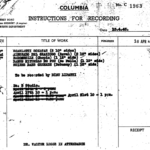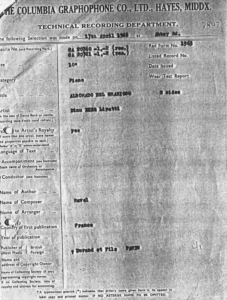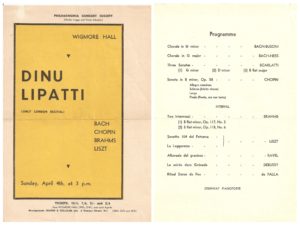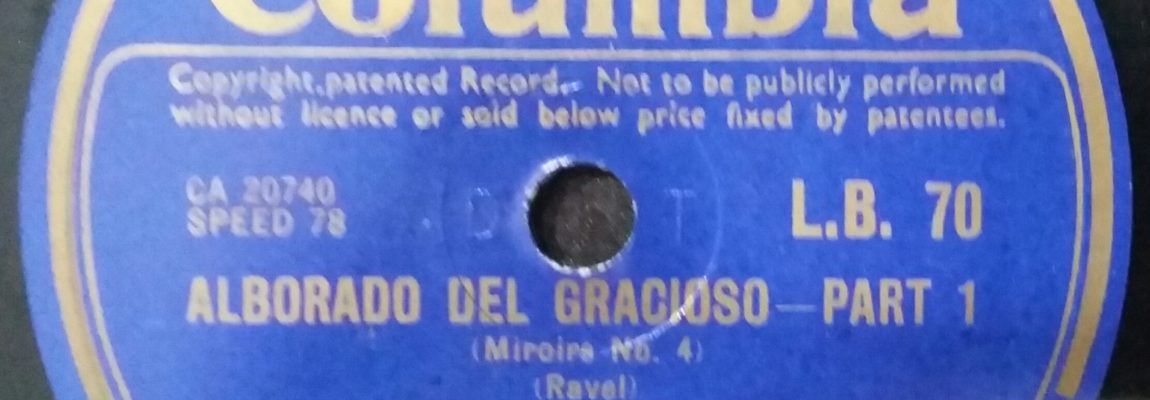The YouTube link at the bottom of this page presents a remarkably clear transfer from a British pressing of a Columbia 78rpm disc featuring Dinu Lipatti’s legendary April 17, 1948 recording of Ravel’s Alborada del Gracioso. This is the only Ravel work and sole contemporary composition he recorded commercially for EMI during his few years under contract with them and has long been hailed as one of the greatest piano recordings ever made.
A myth circulated after Lipatti’s death – perpetuated, oddly enough, by his widow – that the pianist had spontaneously sat down to play the work without having touched it for 6 months and the engineer happened to turn on the machine to start recording him. Here is a recording of an interview in which Madeleine Lipatti recounts this tale in colourful detail:
Three facts supported by printed documents, however, disprove the rather colourful story:

Image Mark Ainley collection.

1) Lipatti had played the work at his Wigmore Hall recital two weeks earlier, on April 4, 1948
2) Alborada had been listed on an Instructions for Recording sheet dated April 15, 1948, two days before the session, meaning that Lipatti had been prepared to record it
3) the recording sheet from the April 17 session indicates that the pianist made two takes of each side of the record, which in 78rpm-disc times means that he did not play through the work uninterrupted
Tantalizingly, Lipatti had also been scheduled to record Debussy’s La soirée dans Grenade and Falla’s Ritual Fire Dance, but there is no evidence to indicate that he did. That said, the chronological recording log at EMI archives that detail exactly what transpired in each session is missing for a 6-month period in 1948, including the date of this session, so we cannot be certain that no attempts at these titles were made.
This disc of Alborada – perhaps the only recording with which Lipatti was ever fully satisfied – at once puts to bed the myth that he was a weak and conventional pianist: it is filled with staggering virtuosity, from the rapid-fire repeated notes through those unbelievable graduated glissandi, and is played with tremendous power and bravura, with remarkable rhythmic bite, towering fortissimos, and glistening tone.

It is of course most regrettable that Lipatti did not record the other works scheduled for the same sessions, as they would have surely – like this disc – given us a very different perspective of his pianism and musicality. Walter Legge wrote that in Lipatti’s Wigmore Hall performance of Falla’s Ritual Fire Dance two weeks before this recording was made, “the crescendo he made in the opening bars rose to such a fortissimo (but still without hitting through the tone) that I expected the Steinway to part in the middle and let him through like the Red Sea at Moses’ behest.” However, we are certainly fortunate that this Ravel performance was recorded, as it gives us a glimpse into a different aspect of Lipatti’s artistry, one that reveals his tremendous power and brilliant musical mind.
Many thanks to collector Tom Jardine for sharing his exceptionally well accomplished transfer of this magnificent performance!

Comments: 5
Great !
Great playing! I was overdue for another listening to this classic performance, so many thanks for posting!
Many thanks for this post
Just too bad we do not have a recording of the Ravel concerto in G from The Amsterdam concert of October,2 1947!
We only have the Bach/Busoni BWV 1052.
Woensdag 1 oktober 1947 20:15 uur Concertgebouw Amsterdam
Donderdag 2 oktober 1947 20:15 uur Concertgebouw Amsterdam
Abonnementsconcert Concertgebouworkest Eduard van Beinum, dirigent
Johann Sebastian Bach (1685-1750) Ferruccio Busoni (1866-1924), arrangement
Klavierconcert in d kl.t., BWV 1052 Dinu Lipatti, piano
Richard Strauss (1864-1949) Metamorphosen Studie voor 23 solo-strijkers
pauze
Maurice Ravel (1875-1937) Pianoconcert in G gr.t. Dinu Lipatti, piano
Manuel de Falla (1876-1946) uit El sombrero de tres picos
– Danza de les vecinos
– Danza del molinero
– Danza Final
Many thanks for this post
Just too bad we do not have a recording of the Ravel concerto in G from The Amsterdam concert of October,2 1947!
We only have tha Bach/Busoni BWV 1052.
Woensdag 1 oktober 1947 20:15 uur Concertgebouw Amsterdam
Donderdag 2 oktober 1947 20:15 uur Concertgebouw Amsterdam
Abonnementsconcert Concertgebouworkest Eduard van Beinum, dirigent
Johann Sebastian Bach (1685-1750) Ferruccio Busoni (1866-1924), arrangement
Klavierconcert in d kl.t., BWV 1052 Dinu Lipatti, piano
Richard Strauss (1864-1949) Metamorphosen Studie voor 23 solo-strijkers
pauze
Maurice Ravel (1875-1937) Pianoconcert in G gr.t. Dinu Lipatti, piano
Manuel de Falla (1876-1946) uit El sombrero de tres picos
– Danza de les vecinos
– Danza del molinero
– Danza Final
Indeed, it’s so unfortunate. I posted about this in my write-up about the Bach Concerto and how it came to be found… it’s still a bit of a mystery why we have the Bach but not the Ravel – but I continue to be hopeful that it will be found. You can see the actual concert programme and read the other details at this link:
http://www.dinulipatti.com/2012/10/the-bach-busoni-d-minor-concerto/